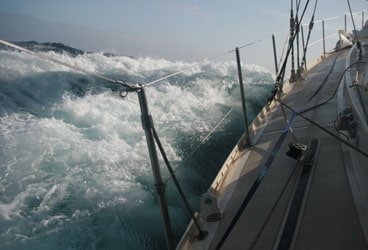
With the Northwest Passage behind us, the Labrador Sea presented the sailors on board /Ocean Watch/ with a new set of challenges.
There are many things about the gale I’ll never forget, but at the top of the list is the fulmar flying backward. It was like something out of The Wizard of Oz. Ocean Watch, our 64-foot cutter, was in the third day of a 35- to 45-knot blow in the Labrador Sea, bound south for Newfoundland, and the gorgeous seabirds had been our companions for several days. Strong, powerful flyers, the fulmars had enthralled us with their airborne prowess and antics; at one point, one had actually flown through our foretriangle, seemingly for the sheer fun of it. But in the staunch northerly breeze, this particular fulmar, beating to windward, couldn’t gain an inch to weather and was actually losing ground. The image is seared in my memory.
Remarkably, with 7,000 nautical miles-as well as the Northwest Passage-now behind us on our bid to sail around the Americas from Seattle to Seattle (www.aroundtheamericas.org), we’d yet to cop a sustained gale-until we sailed into the Labrador Sea on the passage from Pond Inlet, on Baffin Island, to the historic Canadian harbor of St. John’s. Nope, we’d made it across the Gulf of Alaska (where the breeze hovered near gale force, but only for a few hours), through the Bering Strait, past the Arctic Circle (twice!), and down much of the rugged coast of Labrador virtually unscathed. Then, just a few hundred miles from safe harbor in Newfoundland, we got pasted.
The wind swung hard and fast from the southwest to the northwest, and at first, the resulting seaway was spectacularly miserable. But as the gale intensified and then steadied into the north, the seas began to acquire a semblance of rhyme and reason. They also began to build, and build, and build.
We went through the natural progression of reducing sail: double-reefed main and furled genoa; triple-reefed mainsail and staysail; triple-reef main and storm staysail; storm staysail alone. With each sail change, we grew more confident in our choices and our sailhandling. More important, Ocean Watch seemed to revel in the conditions. I’ve said it before, and I’ll say it again: I love a boat that’s better than I am.
For the most part, the wave trains were long and predictable. On one 25-footer-the biggest wave tops were parallel with the first spreader-all the forces in the universe became aligned, and Ocean Watch notched 17.5 knots surfing down its face. Every so often, however, a couple of closely spaced waves knocked the boat off her axis, and before the autopilot could correct things, we found ourselves skidding sideways down the second of the twin liquid peaks. But the old girl always managed to shake it off and get back on her feet, and so did we.
Seventy-two hours into the storm, the winds began to abate, and by the time we sailed into the narrow cut leading to the protected waters of St. John’s, things were back to normal. Ultimately, we’re bound for Cape Horn, and all things considered, the Labrador Sea gale proved to be a pretty good training exercise.
We now know a few things about the boat and ourselves that we didn’t before. And, of course, we also know what it takes to truly frustrate a fulmar.







